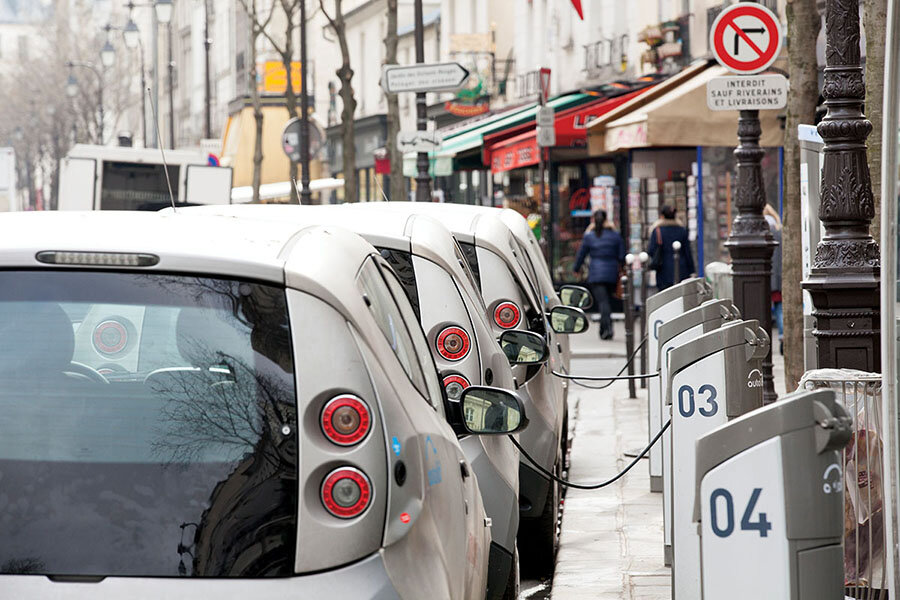Cities eye zero-emission futures
Loading...
Oxford, England, prides itself on its plentiful number of bicycle commuters, as noted by its signs at the city limits that read, “Welcome to the city of Oxford, a cycling city.” In a recent survey, Oxford came in second among British towns with 22 percent of locals riding three or more times a week. Now, the city plans to pedal further ahead by becoming the world’s first zero-emission zone by 2035.
After discovering that 75 percent of Oxford’s pollution came from traffic, the city and county councils decided to create a low-emission zone. Since 2014, only low-emitting vehicles have been allowed within city limits. Buses, a main source of air pollution, began to switch over to low-emission and hybrid fleets. In the past 10 years, Oxford has seen its air pollution drop by one-third.
Oxford’s next target: no pollution. At first, the zero-emission zone will just govern the city’s center, about half a square mile. It will be gradually expanded until the zone covers the entire city by 2035. Gas or diesel vehicles that enter the designated zone will be fined.
Low-emission zones, or similar regulations, are becoming popular among the world’s biggest cities as a means of minimizing air pollution. Often, these regulations are paired with investment in pathways for pedestrians or bikes.
C40 cities, a group of local governments in megacities accounting for 1 in 12 people worldwide, met in Paris at the Together4Climate event in late October to discuss implementing green regulations through local government. After the conference, 12 major cities pledged to buy only zero-emission buses after 2025 and to create fossil fuel emissions-free areas by 2030.
Paris plans to ban diesel cars by 2024 and gas-powered cars by 2030 from its city limits, while also doubling the number of bike lanes and designating certain streets for electric vehicles only. Madrid is redesigning streets to be more pedestrian-friendly and plans to ban cars from its center by 2020. London, which has already improved air quality since the fatal London smog of the 1950s, will establish an ultra-low-emission zone by September 2020.
Not all Oxford residents are thrilled about city plans to go green. John Tanner, an Oxford City councilor, says some residents see the city’s action as an infringement on their individual right to drive the vehicle of their choice.
“[P]eople are quite divided about it,” he says. But both the city and county councils “think that the health of the public and the visitors to Oxford is the most important thing, so we really have to act....”
Car enthusiasts may not have to give up four wheels entirely. As demand for low- or zero-emission cars rises, manufacturers are responding with all-electric or hybrid lineups.
For instance, the BMW plant in Oxford will begin producing an all-electric Mini by 2019. Volvo announced in July that all car models created after 2019 will be either electric or hybrid. Mercedes-Benz will offer an electric version of all car models by 2022, and Volkswagen will follow with an electric version of all car models by 2030.
Advancing car technology and its increasing availability will make zero- and low-emission zones easier to enforce, says Anthony Heyes, Canada research chair in environmental economics at the University of Ottawa, via email. “Of course,” he says, “sales of those cars will be, in turn, given a boost as cities commit to future bans on non-electrics.”
Continuing citywide efforts to ban gas- and diesel-powered cars from the most heavily polluted streets will help. But Noelle Eckley Selin, an associate professor of earth sciences at the Massachusetts Institute of Technology in Cambridge, warns that cities must be sure these pollutants aren’t just displaced.
“For example,” she says, if “someone’s not driving in the city, they’re driving right on the outskirts.... [That] won’t address regional air quality issues.”
But if cities’ bans on gas and diesel vehicles mean more residents switch to electric and hybrid vehicles, then air pollution will continue to decrease.
“[T]aking cars off the road will certainly lessen ... pollution from that source,” says Professor Selin. “It’s not going to completely solve the problem, but it will certainly take a major source out of the equation.”







